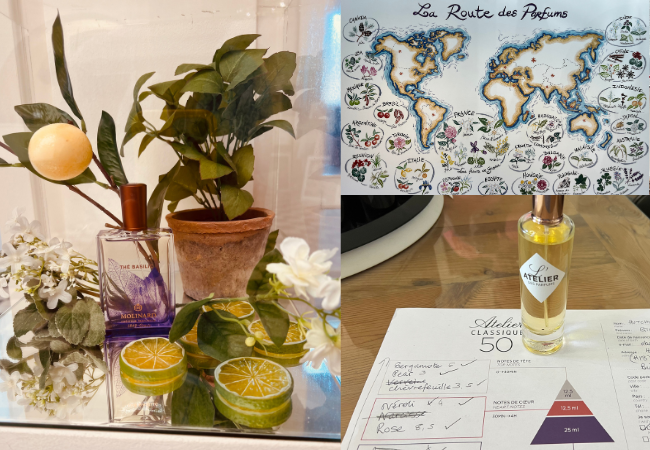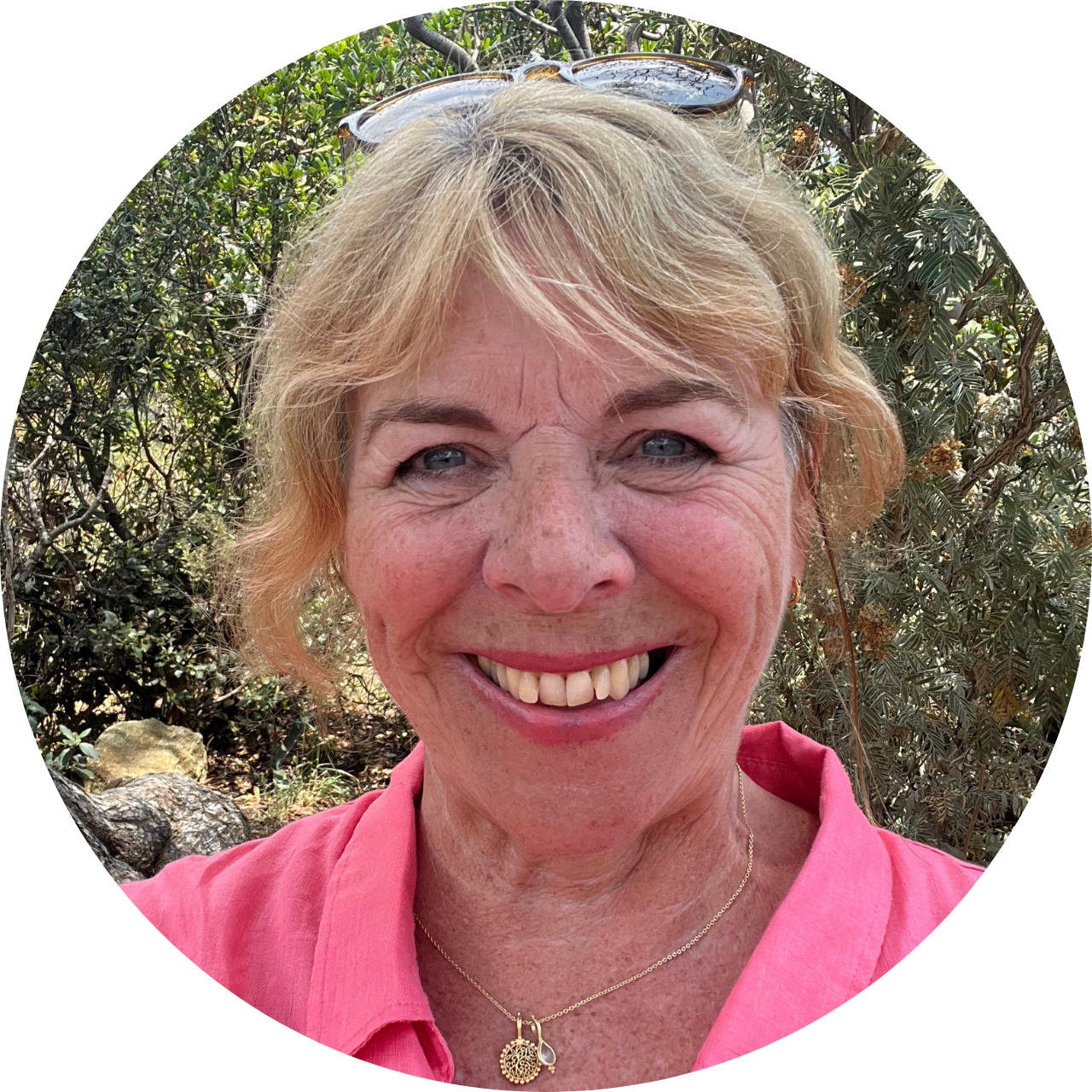The Perfumes of Grasse: Make your own Scent in the World’s Perfume Capital
Did you know you can make your own perfume at workshops offered by famous perfumeries such as Galimard, Fragonard, and Molinard? Join Gillie Hutchinson on the French Riviera as she tries them out…
In the hills north of Cannes lies the heart of the perfume industry – Grasse. It is recognized as the world’s perfume capital with a microclimate that has encouraged the flower farming industry since the end to the 18th Century. Located sufficiently inland to be sheltered from the sea air with an abundance of water thanks to the Siagne Canal, the countryside around Grasse now produces over two-thirds of France’s flowers for perfumes and food flavourings, with an annual turnover of 600 million Euros. Natural aromas from lavender, myrtle, rose, orange blossom and wild mimosa are harvested annually, including 27 tons of jasmine, a key ingredient in many perfumes first brought to Southern France by the Moors in the 16th Century.
There are three leading perfumeries in Grasse – Galinard, established in 1747 by local tanner Jean de Galinard, whose idea of scenting the leather gloves used in the tanneries to disguise the unpleasant odour so impressed Queen Catherine of Medici that the product spread rapidly through high society soon creating a worldwide reputation for Grasse as the ‘Glovers’ Perfumers’. It is the third oldest company in the world (after Farina Gegenuber and Floris of London).
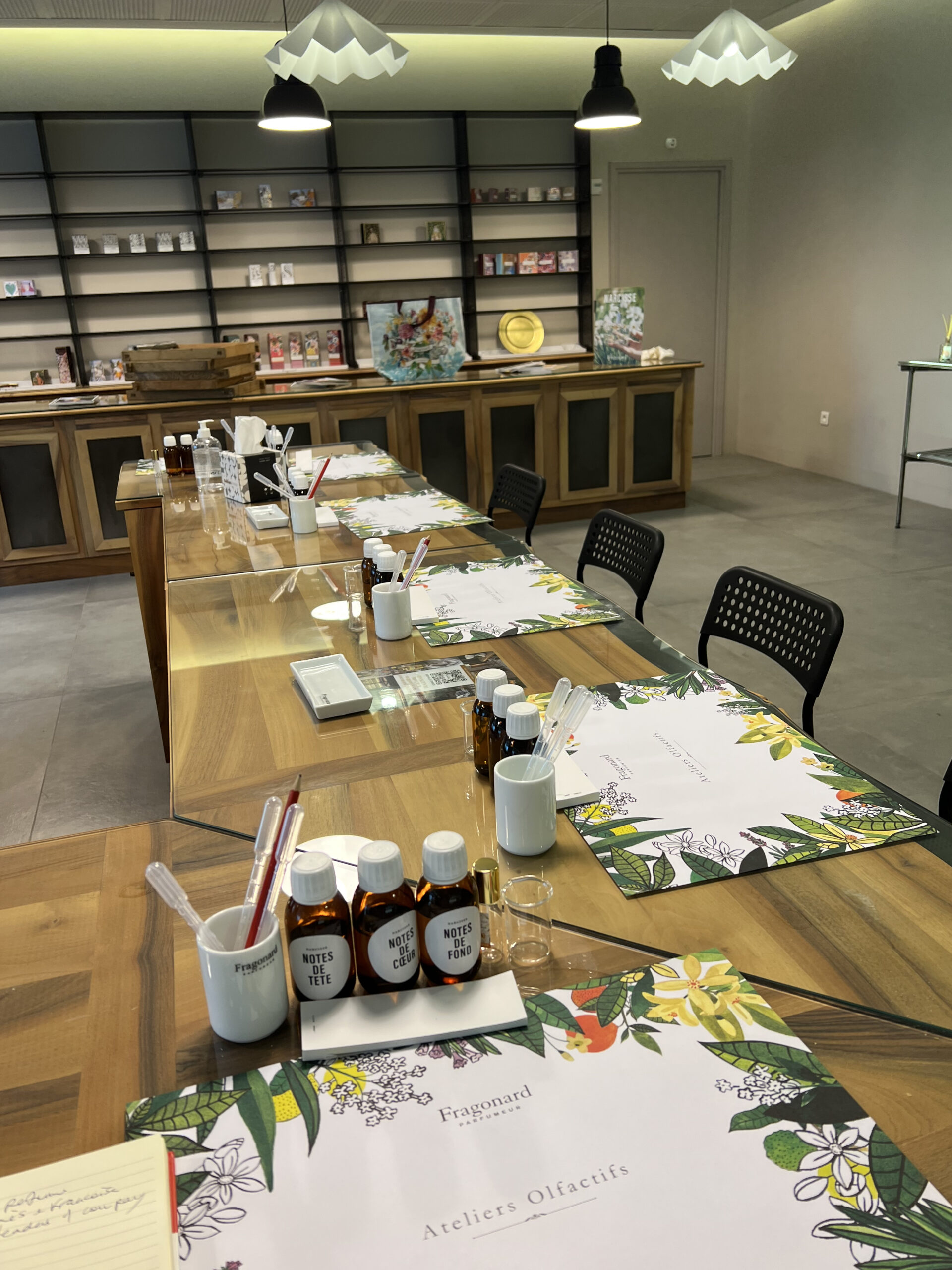
Molinard, established in 1849 by Monsieur Molinard and Monsieur Sittler, bottled its perfumes in Baccarat crystal and Lalique glass. Queen Victoria visited the perfumery in 1891, and in 1939 Molinard won the Exposition in New York for its famous oval flacon. Molinard is now in its fifth generation and led by Celia Lerouge Benard.
Lastly, Fragonard was established in 1926 by Eugene Fuchs and is now in its fourth generation led by Anne, Agnes and Francoise Costa. All product packaging is done by hand at the Fragonard factories in Grasse, Paris and Versailles.
Fascinated by this evolution of perfume and a desire to train my own ‘nez’ in discerning the many different scents, and to make my very own bottle of perfume, I embark on a one-hour ‘Atelier’ at Molinard. It is the month of May and each year the town of Grasse celebrates the rose with magnificent floral street decorations and abundant fountain displays, honouring the flower that has brought the town so much notoriety. Molinard’s impressive red stone building on Blvd. Victor Hugo houses the boutique and museum where our hostess Marie greets us in her chic black dress. As we take the tour past huge brass urns, she explains how the freshly-harvested flowers were spread on racks inside, their essential oils extracted by the steam produced from water heated at the base of the urn. Only the top of the liquid would then be used for perfume-making, and a single Chemist chose the fragrances, blending different scents and allowing them to settle before use.
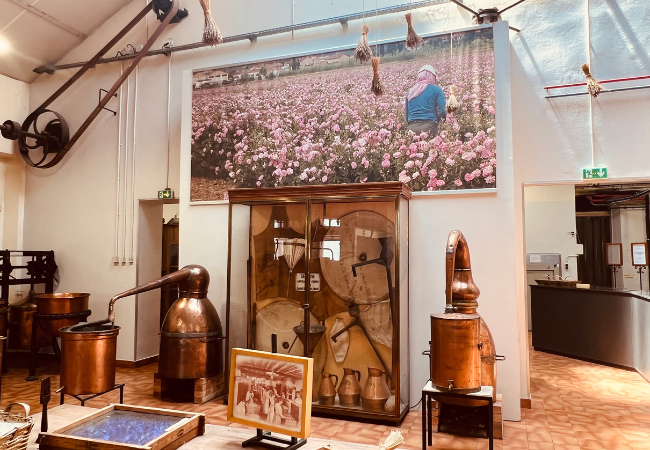
We make our way through the sweet-smelling rose gardens to the Studio next door to begin our workshop. There are five other people in my group and we take our seats at a long table laden with trays of perfume bottles. Marie teaches us that all perfumes are made up of three different notes – Top Notes which offer the initial perfume sensation or smell; Heart Notes which create memories or certain emotions; and Base Notes which linger in a room after you have left. She says it is always best to smell a perfume from the top or lid of the bottle rather than from the bottle itself, and to waft the lid in front of your nose to allow the air to capture the scent. She also advises not to put perfume on your wrists and rub them together for the same reason, and never to store your perfumes in a humid bathroom but rather away from the light in a bedroom or closet. We each have a form to write down the results of our experiments in making our own 50ml bottle of Molinard perfume with a choice of at least a dozen bottles of each perfume ‘Note’ on the table before us. We have paper ‘tester’ strips to insert in any perfume bottle of our choice, and given twenty minutes to select three favourite Top and Heart Notes and five Base Notes. ‘Go with your nose’, says Marie, ‘and trust what you like!’ As she says, this is totally a smelling sensation without relying on touch or sight. The nose knows!
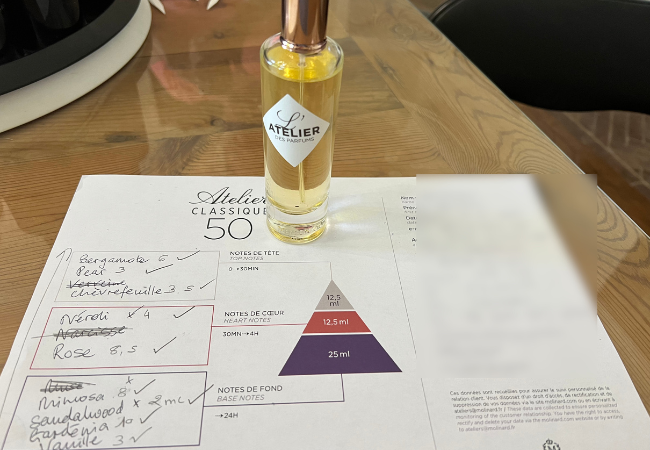
Marie sits with each of us in turn and wafts our tester strips in a fan in front of our noses to get our reaction. Some smells are slightly overpowering and that strip is duly removed. Marie then assigns the percentage of each preferred fragrance, and using 3ml. plastic sucker vials, we carefully extract the stipulated amounts from each perfume to fill our own 50ml. bottle. After a gentle shake, I take a sniff of my new perfume. Marie advises to wait a week before using to allow the blending process. I am awarded my Molinard certificate of attendance outlining my personal perfume ‘recipe’ which will be kept on file at Molinard forever, allowing me to reorder my fragrance at any time in the future. It would be remiss of me not to visit the beautiful boutique in the main building afterwards, where workshop attendees receive a 20% discount on all Molinard products. Note: For those wanting a more private experience, Molinard offers a 2-hour workshop where champagne and macaroons are served. Simply delightful.
GALLERY:Please add some images
As a comparison, I move on to Fragonard to try their ‘Mini Workshop’ for a 15ml bottle of my own creation. The ambiance at the Fragonard factory is very different to that of the rather grand, extravagant Molinard. Here, we are whisked through the modern-day factory, past chemists and packers at work, getting a brief overview of how the soaps are made using olive oil, almond oil, Aloe Vera, Argan oil and glycerine. The soaps are shaped and stamped with the Fragonard logo and spend 5 days cooling. The Grasse factory makes 5,000 soaps a day. In the workshop next to the boutique, we are presented with a small bottle of Bergamot (‘Notes de Tete’), one of Rose and Jasmin (‘Notes de Coeur’), and a third of White Musk and stronger ‘woody’ smells (’Notes de Fond’) – this time the ‘notes’ are already chosen for us. With an allowance of 3ml. of each note, we are left to add another 6ml of our own preference to fill our personal 15ml. bottles. Again, blending and settling will take about a week before we can use our perfume. This time there is no discount in the boutique, but I buy my favourite-smelling Fragonard soaps anyway!
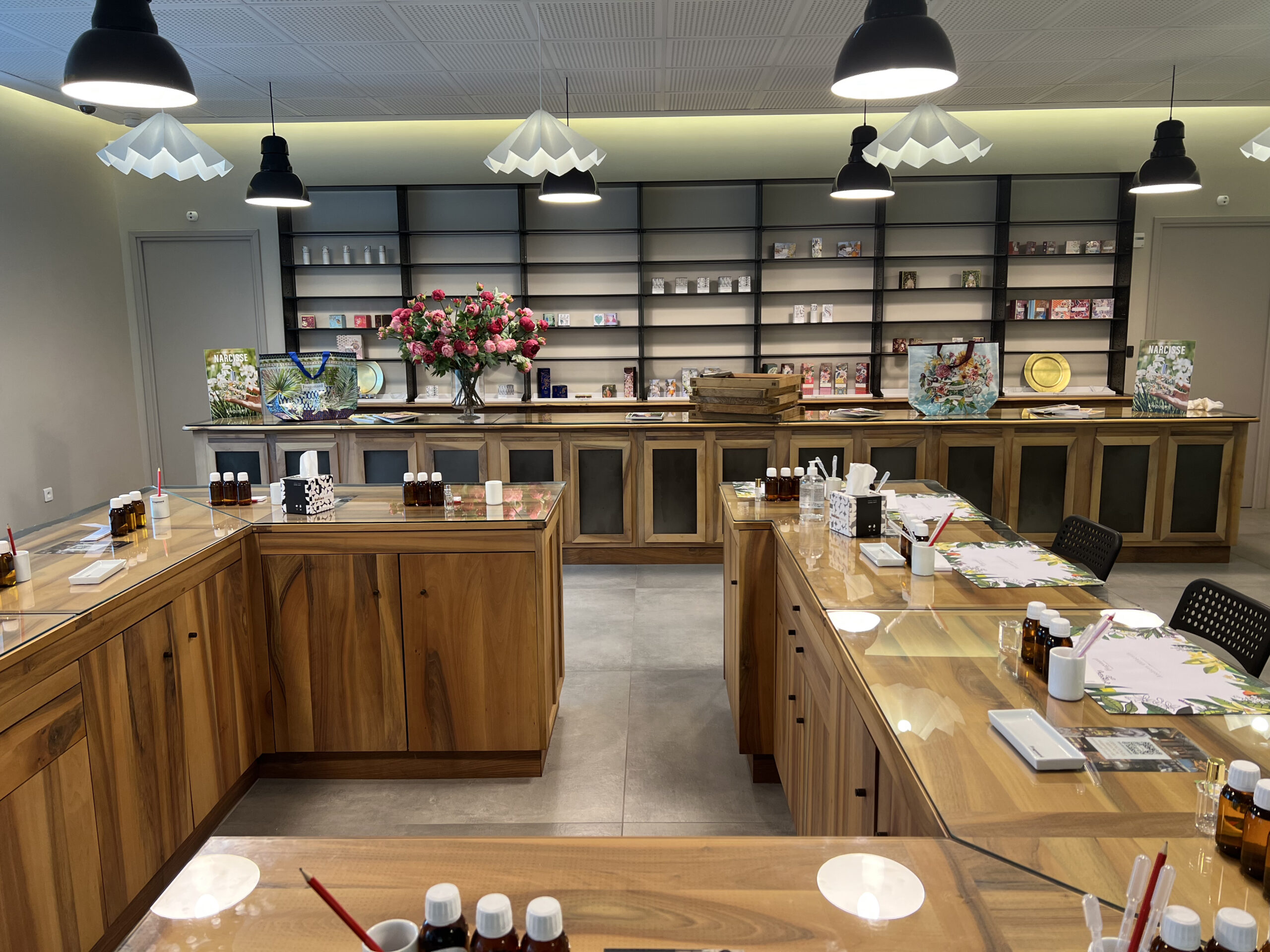
It has certainly been an enlightening afternoon and I leave Grasse in a heady cloud of perfumes, some of my own making! I would whole-heartedly recommend the Molinard Workshop for its value-for-money and more in-depth look at the history of the perfume industry. After all, who can resist returning home with their very own bottle of perfume which can forever be refilled and shipped directly to your door.
Share to: Facebook Twitter LinkedIn Email
More in perfume, Provence-Alpes-Cote d'Azur
